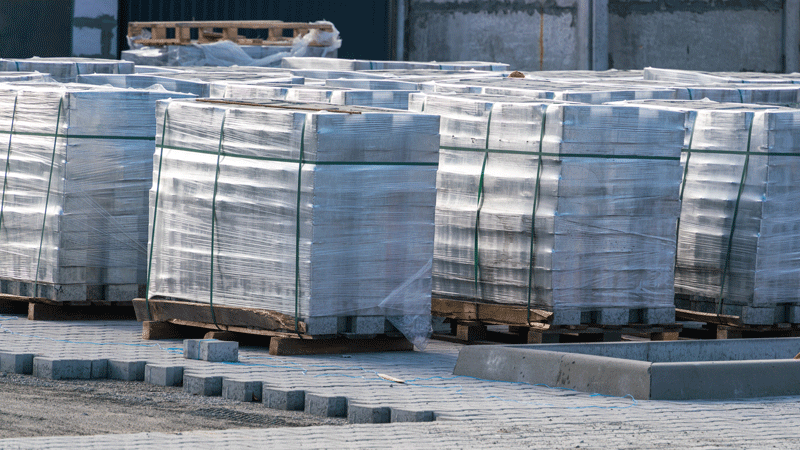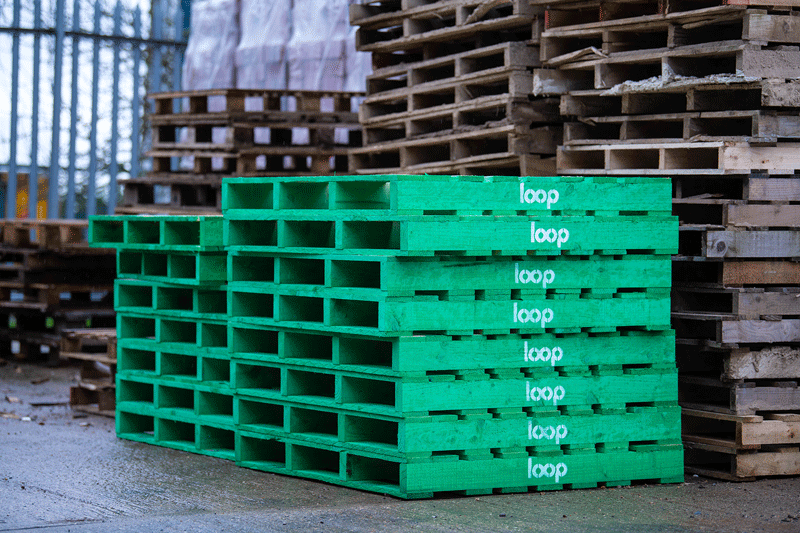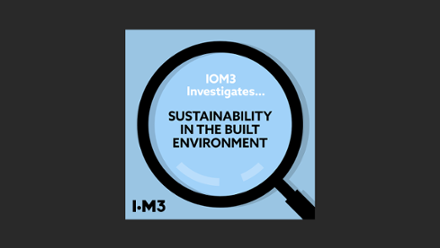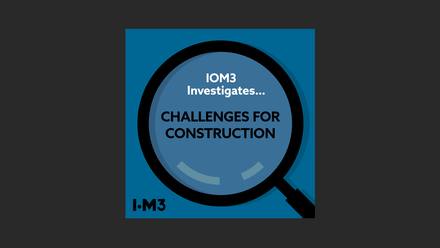Heavy lifting – circular economy in packaging for construction
Chair of the IOM3 Construction Materials Group, Flavie Lowres FIMMM, and Chair of the IOM3 Packaging Group, Jude Allan MIMMM, explore how we can lighten the weighty load of packaging for construction products through the supply chain and embed circular economy principles within the sectors.

The construction industry is large – it employs an estimated 2.4 million people in the UK, making up roughly 7% of all jobs with 37% of the workforce working for themselves. It is also seen as a sector with considerable growth opportunities and, in 2013, the UK Government published the construction industry’s Industrial Strategy and set targets for 2025 to:
- Lower costs by 33%
- Deliver projects 50% faster
- Lower emissions by 50%
- Reduce the trade gap between exports and total imports
- for construction products and materials by 50%
To achieve those goals, the government recognises that the industry needs to be smart – efficient and technologically advanced – and more sustainable. Following the publication of this strategy, the Construction Leadership Council (CLC) was created to ensure that the commitments are delivered.
The government has also been pushing for greater use of Modern Methods of Construction to improve productivity onsite, tackle skill shortages and enhance building performance.
A Board of representatives from both government and industry was also set up to drive forward the actions set out in the Low Carbon Construction Action Plan launched in 2011. The aim of the Green Construction Board is to support and accelerate the delivery of green buildings and infrastructure that are more resource, energy and water efficient and low in carbon, while being safe, fit for purpose, and flexible to meet the changing needs of society and climatic conditions.
In terms of sustainability, the impact of the construction industry on the environment is huge. Figures from Europe state that it consumes 50% of all resource extraction. The CLC’s report on Zero Avoidable Waste in Construction, published in February 2020, shares that the sector is responsible for roughly 50% of greenhouse gas (GHG) emissions in the UK and 63% of all waste is from construction, demolition and excavation.
The construction industry needs to play its fair share in reducing its impact. Net-zero buildings mean a reduction of both embodied and operational carbon, and offsetting once the lowest levels have been achieved. Much of the focus has often been put on the energy demand of buildings. Regulations seek to ensure that buildings are more energy efficient.
Meanwhile, The Aggregate Levy, a tax on the use of virgin aggregates, has supported the use of more recycled materials since 2002. The aforementioned CLC report reveals that 90% of construction and demolition waste is recovered in the UK, however, there is still a push for the waste to be upcycled – currently, much inert waste is crushed and used as fill on construction sites.
Voluntary schemes, such as the Building Research Establishment's Environmental Assessment Method (BREEAM), have long been used to reduce the impact of the industry and buildings. The demand for such schemes has increased exponentially over the last 10 years and have a positive impact on a sector that has become more aware of the environmental impact of construction products and the sourcing of such products.
In 2021, the Green Construction Board published a roadmap for zero avoidable waste in construction. It states that waste costs the construction industry an estimated £11bln per annum and emits 3.5Mt of CO2e. It is estimated that a third of construction waste is packaging by volume, and the construction industry is the second largest producer of packaging waste.
En route to resource efficiency
The Routemap for Zero Avoidable Waste, released in July 2021, brings together the UK construction industry, identifying actions to generate less material waste across the building lifecycle, with a pathway to prevent, reuse and recycle more.
It was prepared by the Green Construction Board, in collaboration with the UK Departments for Environment, Food & Rural Affairs, and Business, Energy & Industrial Strategy. It is supported by the Construction Leadership Council, which leads on strategic government and industry issues for the sector.
Actions are identified across the construction industry (infrastructure and building) and apply to new and existing buildings and structures.
New buildings and structures should use resources efficiently, be designed for durability, longevity and safety, as well as for deconstruction and disassembly at end of life. For existing buildings and structures that are approaching the end of their current use, the routemap urges the industry to repurpose them for new uses, and if not possible, demolish them in a way to ensure the maximum amount of product and material is reused, recycled or recovered.
Key targets include: reducing costs by 10% by 2030 by designing out waste and material optimisation; eliminating all but hazardous construction and demolition waste entering landfill by 2040; and zero soil to landfill by 2050 unless require for landfill operation.
Find out more at bit.ly/3JgmFlX.
Building a picture of packaging
There are specific legislative changes afoot relating to all packaging, including that used in the construction industry, to drive recycling and reduction of waste.
The Plastic Packaging Tax came into effect on 1 April and levies a tax of £200/t on plastic packaging that does not contain a minimum of 30% recycled content. It has prompted much discussion across the packaging industry about the availability of recycled material and the infrastructure necessary to supply the required 30% recycled content.
The construction industry like others will be required to have the relevant detailed information about the plastic packaging it uses to mitigate the Tax – as a minimum packaging producers and importers who manufacture or import 10 or more tonnes of plastic within a 12-month period will need to keep clear records of material source, polymer type and the amount of recycled content.
The Environment Act 2021 put forward a suite of policies, one of which is the Packaging Extended Producer Responsibility (EPR) scheme, which will place the responsibility for the full net cost of recovering and recycling packaging on the brand owner or importer when it is introduced next year.
EPR will replace the Packaging Waste Recovery Note (PRN) system, however, it will apply to all packaging so whether you currently pay PRNs or not you will have an obligation. While the details are yet to be finalised, EPR is likely to lead to huge increases in costs throughout the supply chain. Costs to business in the first year of EPR are estimated to be £2.7bln based on the UK Government’s updated Impact Assessment.
Producers will also be required to determine the recyclability of their packaging, and modulated fees will be based on recyclability, recycling rate and littering, meaning that there will be lower costs for more recyclable packaging. While most of the discussion around Packaging EPR tends to focus on food and drink packaging, the new regulations will apply to all sectors, including construction.
- Waste from new build costs the UK construction industry an estimated £11bln per annum and emits 3.5Mt of CO₂e.
- This amounts to 60Mt of construction and demolition waste and 51Mt of excavation waste.
- A third of construction waste is packaging by volume.
- The UK construction industry is the second largest producer of packaging waste.
The lay of the land
Given the volume of construction packaging waste, the creation of well-designed and effectively managed packaging, including recycled content and recyclability, will have a positive impact on the construction sector’s drive towards zero avoidable waste to landfill, as well as reducing its tax and waste management liability as set out in the government’s Our waste, our resources: a strategy for England.
The packaging used in construction is largely made up of cardboard, plastics, paper and wood. The key functions are to protect the product, move them around safely, and provide branding and product specific information. All of which, if done effectively, can help to reduce waste and provide health and safety benefits.
The environment in which construction products are stored and used is variable, with some products outside in all weathers. Effective protection from transportation, site storage and weather damage can have a significant impact in reducing wasted product.
The packaging mix changes through the construction process as the products themselves change from pallets of bricks and large-scale construction elements in the build phase, to the mechanical and electrical elements and fixtures in the fit-out phase.
There is therefore much work needed to understand the type of packaging used, and how it is managed on a construction site and in a waste management facility, to achieve the targets set out in the Resources and Waste Strategy, published by the UK Department for Environment, Food & Rural Affairs and the Environment Agency to eliminate avoidable waste of all kinds (including plastic waste) by 2050.
Brick manufacturer tackles plastic packaging
Brick manufacturer Wienerberger has removed coloured ink and branding from its plastic packaging so that it can be recycled as a higher-grade material.
Removable paper labels will now contain the information that was previously printed onto the packaging, including product name, details and handling advice.
The company will trial collections of used materials from customers to recycle the plastic into new packaging.
Meanwhile, the company’s procurement, operations, and health and safety teams have worked with customers and logistics partners to also reduce the volume of plastic packaging materials (foils) used. They have run extensive trials with both reduced foil thickness and foil-free packaging.
The overall aim is to reduce raw material consumption through a phased reduction in plastic packaging by 30% by 2023 compared to 2019 levels.
Collaboration is needed across the value chain from product manufacturer, merchant, construction company and subcontractors, through to waste management, to optimise packaging formats and systems that go beyond what they currently do. Any developments need to be fit for purpose, use recycled content and recyclable material where possible, with robust waste management practices onsite to ensure material is actually collected for recycling.
But while recycling is obviously better than not recycling, it is not the solution that will solve all the challenges – it is also important to look at packaging systems and formats that are designed for reuse and where possible to reduce the amount of packaging used.
The construction industry has some interesting examples of reuse for a closed loop system (see box-out below on the Pallet Loop).
Eliminating avoidable pallet waste

Pallet LOOP is a deposit-based reuse scheme – founded as a 50/50 joint venture by some of the leading names in the UK pallet industry – to eliminate avoidable pallet waste in the UK construction sector. It aims to incentivise pallet returns via a deposit-based system with a 72-hour turnaround on the collection of its green LOOP pallets.
The goal is to provide construction companies with a “greener, safer, leaner way of transporting building materials”, away from the linear practice of “deliver, distribute and discard” to “recover, repair, reuse”.
Every year around 18 million pallets are manufactured for UK construction, with estimates suggesting less than 10% are currently reused. This lack of pallet reuse generates vast volumes of waste – more than 250,000t – and uses a huge amount of timber unnecessarily, around 6,000 acres of forestry per annum.
Designed as a net-carbon-zero model, the Pallet LOOP offers a range of pallet designs that are built for multiple trips. With an ISO14040 compliant lifecycle analysis, the 100% FSC pallets have been engineered to last and are, on average, said to be more than 100% stronger than standard pallets.
BAM, Lovell, Morgan Sindall, Wilmott Dixon and Wolseley Group are among a growing number of companies that have signed a charter acknowledging that change is required when it comes to pallet consumption and committing to a comprehensive evaluation of how Pallet LOOP could be integrated within their business to help cut waste. Pallet LOOP is timetabled for operational roll-out in late 2022.
Thinking outside the box
There are changes that are making an impact in the construction industry to establish viable reuse, recovery of material and take-back schemes. The Alliance for Sustainable Building Products (ASBP) and the Considerate Constructors Scheme are looking at ways to reduce plastic waste within the sector, including plastic packaging.
Data will be key to implement and evaluate these policies.
We need effective data to measure and assess change, evaluating the rate of change and identifying any unintended consequences.
Data is also needed to identify better management of packaging materials at a site level. The success of the proposed reforms and the drive to achieve targets will rely on accurate, robust, high-quality data with sufficient granularity.
The ZAP project, led by the ASBP, and funded by Ecosurety, is researching and developing scalable solutions to combat the prevalence of avoidable plastic packaging waste in construction, much of which is not recycled. This involves working with project partners, Cullinan Studio, Bankside Open Spaces Trust and Mace and Morgan Sindall on real-world construction projects to build case studies and provide training and guidance that will demonstrate the positive actions the whole supply chain can implement, helping many organisations reach zero avoidable waste.
The project is addressing the issues of little substantive data for construction product packaging and a lack of holistic understanding of the various formats that are used for the array of products that enter a construction site and their management both on- and offsite. The aim is to understand key types of plastic packaging arising in construction sites and identify opportunities for reduction and better management across the construction lifecycle.
Working with the project partners, the economic, environmental and other costs and benefits of changing practices will be evaluated with stakeholders from the construction packaging supply chain. At least five major forms of construction packaging will be prioritised and robustly assessed for business as usual versus alternatives.
The future role of packaging in the reduction of construction waste is essential, but the materials, formats and systems may be quite different to what they are today.




